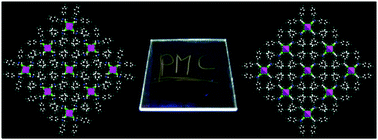Impact of crystalline packing on the mechanochromic luminescence properties of copper based compounds: towards functional coatings†
Abstract
Mechanochromic luminescent materials exhibit a reversible change of the emission wavelength in response to external mechanical forces. These properties are particularly appealing for applications as memory or sensor devices. In order to rationally design and develop such materials, an in-depth understanding of the mechanochromic mechanisms is highly required. In this work, a comparative study of two copper iodide compounds whose difference lies in the subtle modification of the ligands has been conducted. These two clusters present very close crystalline structures but strikingly different optical properties with only one of them exhibiting luminescence mechanochromic properties. Structural and optical characterizations demonstrate that the two clusters endorse different internal stresses due to slight differences in the crystal packing controlled by the nature of the ligands. The release of these constraints upon mechanical solicitation leads to modification of the intramolecular interactions and is at the origin of the observed mechanochromic properties. Additionally, by taking advantage on the sensitive and highly contrasting mechanochromic properties of the clusters, the preparation and characterization of functional coatings on a glass substrate are also presented. An intense signal is observed upon mechanical solicitation which can be erased upon mild thermal treatment.


 Please wait while we load your content...
Please wait while we load your content...